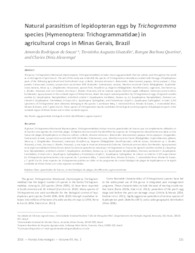Natural parasitism of lepidopteran eggs by Trichogramma species (Hymenoptera: Trichogrammatidae) in agricultural crops in Minas Gerais, Brazil.
Natural parasitism of lepidopteran eggs by Trichogramma species (Hymenoptera: Trichogrammatidae) in agricultural crops in Minas Gerais, Brazil.
Author(s): SOUZA, A. R. de; GIUSTOLIN, T. A.; QUERINO, R. B.; ALVARENGA, C. D.
Summary: The genus Trichogramma Westwood (Hymenoptera: Trichogrammatidae) includes insect egg parasitoids that are widely used throughout the world as control agents of pest insects. The aim of this study was to identify the species of Trichogramma naturally associated with the eggs of lepidopteran pests of the following agricultural and horticultural crops: collards, Brassica oleracea L. (Brassicales: Brassicaceae); papaya, Carica papaya L. (Capparales: Caricaceae); tomato, Lycopersicon esculentum Mill. (Solanales: Solanaceae); cassava, Manihot esculenta Crantz (Malpighiales: Euphorbiaceae); banana, Musa sp. L. (Zingiberales: Musaceae); passion fruit, Passiflora sp. Degener (Malpighiales: Passifloraceae); sugarcane, Saccharum sp. L. (Poales: Poaceae); and corn (maize), Zea mays L. (Poales: Poaceae); and an invasive species (Sodom?s apple milkweed, Calotropis procera Aiton; Gentianales: Apocynaceae) in the semiarid region of Minas Gerais, Brazil. We report natural parasitism by Trichogramma in eggs of Agraulis vanillae vanillae (L.) (Lepidoptera: Nymphalidae), Antichloris eriphia F. (Lepidoptera: Arctiidae), Danaus sp. (L.) (Lepidoptera: Nymphalidae), Diatraea saccharalis F. (Lepidoptera: Crambidae), Erinnyis ello L. (Lepidopera: Sphingidae), and Protambulyx strigilis L. (Lepidopera: Sphingidae). In total, 2,242 specimens of Trichogramma were obtained, belonging to the species T. pretiosum Riley, T. manicobai Brun, Moraes & Soares, T. marandobai Brun, Moraes & Soares, and T. galloi Zucchi. These species of Trichogramma may be candidates for biological control programs of lepidopteran pests in the semiarid region of Minas Gerais and in other semiarid regions.
Publication year: 2016
Types of publication: Journal article
Unit: Embrapa Mid-North
Observation
Some of Embrapa's publications are published as ePub files. To read them, use or download one of the following free software options to your computer or mobile device. Android: Google Play Books; IOS: iBooks; Windows and Linux: Calibre.
Access other publications
Access the Agricultural Research Database (BDPA) to consult Embrapa's full library collection and records.
Visit Embrapa Bookstore to purchase books and other publications sold by Embrapa.

